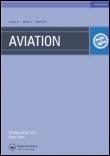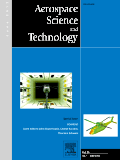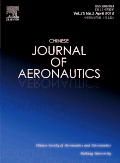
Aviation
Scope & Guideline
Pioneering insights in the world of aerospace technology.
Introduction
Aims and Scopes
- Aviation Safety and Risk Management:
Research in this area emphasizes methodologies and frameworks for enhancing safety protocols, risk assessment models, and accident investigation processes in aviation. - Aerospace Engineering and Technology Development:
This includes studies related to aircraft design, aerodynamics, materials science, and innovative technologies like unmanned aerial vehicles (UAVs) and advanced propulsion systems. - Human Factors and Training in Aviation:
Focuses on the human element in aviation, including training methodologies for air traffic controllers and pilots, crew resource management, and ergonomics. - Sustainability and Environmental Impact:
Investigates the environmental implications of aviation operations, including fuel efficiency, emissions reduction, and the use of alternative fuels. - Data Analytics and Machine Learning Applications:
Explores the application of data science and machine learning techniques in various aviation contexts, such as predictive maintenance, operational efficiency, and traffic management. - Air Transport Economics and Management:
Examines the economic aspects of aviation, including airline business models, market dynamics, and recovery strategies in response to global challenges.
Trending and Emerging
- Machine Learning in Aviation:
The application of machine learning techniques for predicting safety outcomes, optimizing operations, and enhancing decision-making processes has surged, indicating a significant trend towards data-driven methodologies. - Sustainable Aviation Practices:
Research focusing on sustainability, including biofuels, emissions reduction strategies, and energy-efficient technologies, has become increasingly prominent as the industry seeks to address environmental concerns. - Unmanned Aerial Vehicles (UAVs) and Autonomous Systems:
The exploration of UAVs, including their applications in various sectors such as surveillance, delivery, and agriculture, has gained substantial attention, showcasing the growing relevance of autonomous aviation technologies. - Digitalization and Automation in Aircraft Operations:
Emerging themes around digital transformation, including the use of advanced simulations, automated systems, and digital maintenance solutions, reflect the industry's shift towards integrating technology in operational processes. - Human Factors and Crew Performance Optimization:
An increased focus on the psychological and ergonomic factors influencing crew performance and safety management highlights the importance of human factors in aviation operations.
Declining or Waning
- Historical Analysis of Aviation Incidents:
Research focused on historical accident investigations and their implications for current practices has become less frequent, indicating a shift towards more proactive safety measures rather than retrospective analyses. - Basic Aerodynamics Studies:
Although fundamental aerodynamic studies were once prevalent, there seems to be a declining interest in basic theoretical aerodynamics as research shifts towards applied and computational studies. - Conventional Fuel Technologies:
There is a noticeable decrease in research related to traditional aviation fuel technologies, reflecting a broader industry trend towards sustainable and alternative fuel research. - Regulatory Compliance Studies:
Studies focusing on regulatory frameworks and compliance issues appear to be waning, likely due to an increasing focus on innovative practices and technologies that go beyond mere compliance.
Similar Journals

International Journal of AEROSPACE Psychology
Innovating Insights into Aerospace BehaviorInternational Journal of Aerospace Psychology is a premier publication dedicated to advancing the interdisciplinary field of aerospace psychology, addressing the cognitive, emotional, and behavioral aspects of human interaction with aerospace environments. Published by Taylor & Francis Inc., this journal occupies a pivotal position in the academic landscape with its Q2 ranking in Aerospace Engineering and Q3 rankings in Applied Psychology and Computer Science Applications, reflecting its commitment to high-impact research. With an ISSN of 2472-1832 and E-ISSN of 2472-1840, it is accessible through open access options, ensuring that cutting-edge research reaches a wide audience of researchers, practitioners, and students. Covering a broad scope from psychological implications in aerospace systems to educational methodologies in this domain, the journal spans converged years from 2017 to 2024. The Scopus rankings further reinforce the journal's significance, with notable standings within multiple categories, making it an essential resource for those at the intersection of aerospace, psychology, and technology.

Aerospace Science and Technology
Transforming Ideas into Aerospace InnovationsAerospace Science and Technology, published by ELSEVIER FRANCE-EDITIONS SCIENTIFIQUES MEDICALES ELSEVIER, is a leading journal in the field of aerospace engineering, boasting an impressive 2023 Q1 ranking and a significant position in the Scopus Ranks, where it stands at Rank #7 out of 153 in the Engineering - Aerospace Engineering category, reflecting its credibility and impact with a 95th percentile ranking. Since its inception in 1997, this journal has provided a robust platform for the dissemination of pioneering research and advancements in aerospace technology, focusing on innovative methodologies and applications in the aerospace sector. With a commitment to open access, researchers, professionals, and students can easily engage with cutting-edge findings that drive the industry forward. The journal not only seeks to expand knowledge but also aims to foster collaboration among scholars across the globe, making it an essential resource for anyone looking to stay at the forefront of aerospace innovation. For more information, visit its website or refer to its dedicated address at 65 Rue Camille Desmoulins, CS50083, 92442 Issy-Les-Moulineaux, France.

Journal of the Global Power and Propulsion Society
Unleashing Potential through Collaborative ResearchJournal of the Global Power and Propulsion Society, published by GLOBAL POWER PROPULSION SOC, is a premier open-access journal established in 2017, dedicated to the dissemination of innovative research and advancements in the fields of aerospace engineering, industrial and manufacturing engineering, and mechanical engineering. Based in Zug, Switzerland, this journal provides a critical platform for researchers, professionals, and students to engage with cutting-edge studies and emerging technologies that are pivotal to the aerospace and propulsion sectors. With an impressive categorization in the Q2 quartile for multiple engineering specialties in 2023, the journal reflects its commitment to quality and rigor in its peer-reviewed articles. Moreover, it holds substantial visibility in the academic community, as evidenced by its Scopus rankings. The Journal of the Global Power and Propulsion Society stands at the intersection of innovation and collaboration, aiming to foster knowledge sharing globally while enhancing the operational capabilities of power and propulsion technologies.

Chinese Journal of Aeronautics
Connecting scholars to the skies of tomorrow.Chinese Journal of Aeronautics, published by Elsevier Science Inc, serves as a premier platform for cutting-edge research in the field of aerospace and mechanical engineering. With an impressive impact factor that reflects its significant contribution to the discipline, this Open Access journal has been disseminated globally since 2002, allowing unrestricted access to high-quality articles and research findings. The journal is recognized for its exceptional ranking, holding a prestigious Q1 category in both Aerospace Engineering (Rank #8/153, 95th percentile) and Mechanical Engineering (Rank #46/672, 93rd percentile) as of 2023. It publishes original research, reviews, and technical notes that enhance our understanding of aeronautics and its applications, making it an essential resource for researchers, professionals, and students alike. Located in New York, USA, the journal continues to foster innovation and collaboration in aeronautical sciences, shaping the future of aviation and space exploration.

TRANSACTIONS OF THE JAPAN SOCIETY FOR AERONAUTICAL AND SPACE SCIENCES
Connecting Ideas, Inspiring Innovations in AerospaceTRANSACTIONS OF THE JAPAN SOCIETY FOR AERONAUTICAL AND SPACE SCIENCES is a distinguished journal published by the Japan Society for Aeronautical and Space Sciences, focusing on the latest advancements and research in the fields of aerospace engineering and space and planetary science. With a broad range covering theoretical studies, practical applications, and experimental research, this journal serves as a vital platform for researchers, professionals, and students keen to explore the intricacies of aeronautics and space technologies. Although currently closed to open access, the journal maintains a significant presence in the academic community, boasting a 2023 Scopus ranking of Q3 in both of its respective fields and offering insights that contribute to ongoing discussions and innovations in aerospace. Since its inception in 1969 and with publications extending to 2024, the journal not only reflects the evolving landscape of aeronautics and space sciences but also encourages discourse that paves the way for future breakthroughs. For your engagement and contributions to this dynamic field, the TRANSACTIONS OF THE JAPAN SOCIETY FOR AERONAUTICAL AND SPACE SCIENCES stands as an essential resource.

Aerospace is a premier open-access journal published by MDPI, established in 2014 and dedicated to the dynamic field of aerospace engineering. With an impressive Q2 ranking in the 2023 category of Aerospace Engineering, this journal is a vital resource for researchers, professionals, and students interested in advancements and innovations in aerodynamics, avionics, propulsion, and more. Operating from Switzerland, Aerospace provides a platform for the dissemination of high-quality research articles and reviews, contributing to the ongoing dialogue in the aerospace community. This journal not only enhances visibility through its open access model but also ensures that critical knowledge is freely available, fostering collaborative efforts and inspiring the next generation of aerospace engineers. With a Scopus ranking of #60 out of 153 in the Aerospace Engineering category, it plays a significant role in shaping the future of aviation and space exploration.

Aerospace Research in Bulgaria
Contributing to the global dialogue in aerospace science.Aerospace Research in Bulgaria is a prestigious academic journal dedicated to advancing the field of aerospace engineering and technology. Published by the BULGARIAN ACADEMY OF SCIENCES, SPACE RESEARCH & TECHNOLOGY INSTITUTE (SRTI-BAS), this journal serves as a key platform for researchers, engineers, and professionals seeking to share original research, innovative technologies, and critical reviews related to aerospace applications. With the ISSN 1313-0927 and E-ISSN 2367-9522, the journal aims to contribute significantly to the global aerospace community. Although the journal operates under a traditional access model, it emphasizes the importance of research collaboration and disseminating knowledge in the ever-evolving aerospace sector. The editorial team is committed to maintaining high standards in peer review, making it an essential resource for academics and practitioners alike. Located at ACAD. GEORGI BONCHEV STR., SOFIA 1113, BULGARIA, this journal not only highlights Bulgarian contributions to aerospace research but also aims to engage with a broader international audience, fostering advances that propel the industry forward.

Journal of Aerospace Technology and Management
Elevating Aerospace Innovation and Management.The Journal of Aerospace Technology and Management, published by the Instituto de Aeronáutica e Espaço (IAE), serves as a pivotal platform for the dissemination of innovative research in the fields of Aerospace Engineering and Computational Mechanics since its inception in 2009. With an ISSN of 1984-9648 and an E-ISSN of 2175-9146, this Open Access journal facilitates unrestricted access to quality research, fostering knowledge sharing and collaboration among researchers, professionals, and academic institutions worldwide. Based in Brazil, it ranks in the Q3 category according to the latest metrics (2023), highlighting its growing influence and relevance in the competitive landscape of aerospace studies. The journal currently boasts notable Scopus rankings, ensuring that published works achieve widespread recognition and impact within the scientific community. Its diverse scope encompasses a blend of theoretical and applied research, making it an indispensable resource for those seeking to explore groundbreaking advancements in aerospace technologies and management.

International Journal of Aerospace Engineering
Unlocking Potential in Aerospace EngineeringThe International Journal of Aerospace Engineering, published by HINDAWI LTD, stands at the forefront of innovation and research in the field of aerospace engineering. With an impact factor reflecting its contributions to the discipline and classified in Quartile 3 (Q3) for the year 2023, this journal provides a platform for high-quality, peer-reviewed articles that delve into advancements and challenges in aerospace technology and applications. Since its inception in 2008, the journal has embraced an Open Access model, promoting unrestricted dissemination of research findings to foster collaboration and knowledge sharing among researchers, professionals, and academia. The journal covers a broad spectrum of topics, aiming to enhance understanding and give insight into aerospace engineering's multifaceted aspects. With its coverage in the Scopus database, ranking 71 out of 153 in the aerospace engineering category, the journal is a valuable resource for those engaged in this dynamic field, ensuring that high-impact research receives the visibility it deserves.

Maritime Business Review
Fostering Collaboration in International Maritime StudiesMaritime Business Review, published by Emerald Group Publishing Ltd, is a leading academic journal dedicated to advancing knowledge in the fields of maritime business, transportation, and management. With an ISSN of 2397-3757 and E-ISSN of 2397-3765, this journal has established itself as a vital resource for researchers and practitioners alike, particularly noted for its contribution to the domains of Business and International Management, Management of Technology and Innovation, Strategy and Management, and Transportation. The journal is ranked in the prestigious Q2 quartile in each of these categories as of 2023, reflecting its impactful research and relevance in contemporary academic discourse. Although currently not an Open Access journal, it offers robust access options through institutional subscriptions—making its rich repository of cutting-edge research readily available to scholars and professionals. Since its inception in 2016 and continuance to 2024, Maritime Business Review has emerged as an essential platform for both emerging and established academics to share innovative insights and enhance collaborative efforts within the international maritime business community.